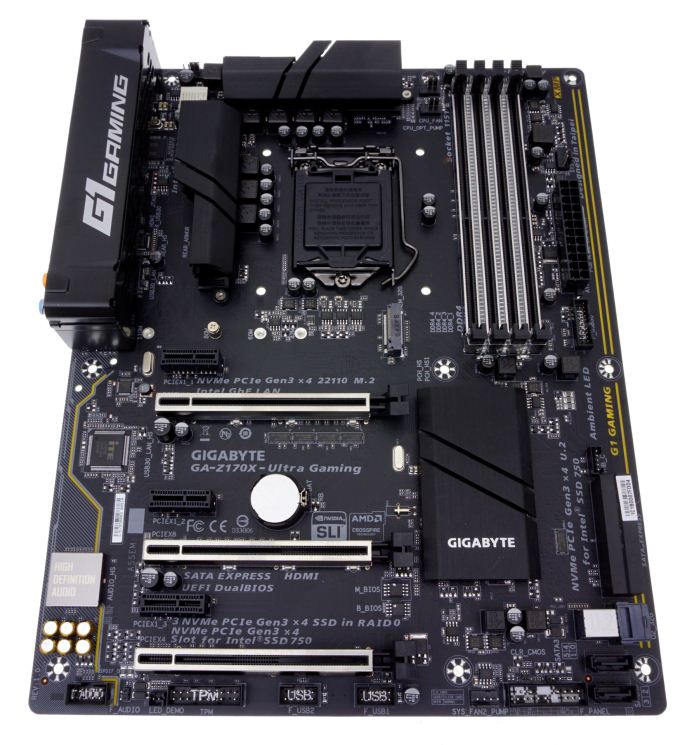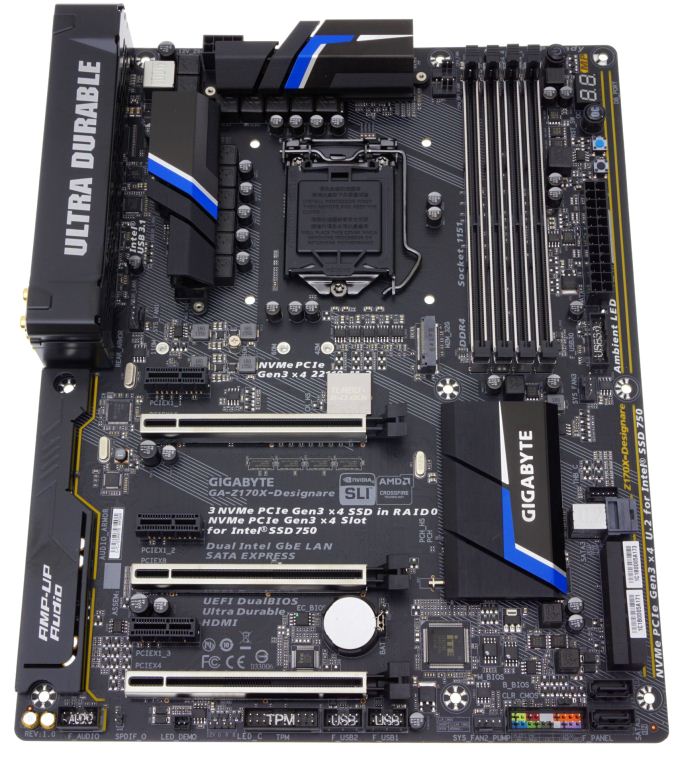The GIGABYTE Z170X-Ultra Gaming & Z170X-Designare Motherboard Review
by E. Fylladitakis on December 28, 2016 10:00 AM ESTConclusion
Both of the GA-Z170X-Ultra Gaming and the GA-Z170X-Designare have been designed to introduce U.2 drive support and allow for the installation of up to three U.2 drives (using adapters). Both of the boards are strongly based on storage solutions that are either dead (SATA Express) or currently evolving in the market (U.2). The SATA Express protocol never gained any traction and there currently are not any consumer products available at all, whereas the currently available U.2 drives are less than a dozen enterprise-level products with ludicrous price tags. That being said, some of them are nice and fast, if your wallet is deep enough. Both boards also offer USB 3.1 via Intel's Alpine Ridge controller, and claim so support Power Delivery 2.0 up to 100W (unfortunately we don't have the hardware to test this).
GA-Z170X-Designare
In order to bring U.2 support to the Z170 while keeping the final cost reasonable, GIGABYTE had to make certain sacrifices. PCIe lane sharing aside, the company had to remove certain features that sopme people might take for granted on motherboards this expensive, such as the HDMI 2.0 port. Although the use of an HDMI 2.0 port on a GPU-focused gaming motherboard would probably be redundant, we cannot justify its omission on the GA-Z170X-Designare, a motherboard aimed towards professionals.
In our eyes, the GA-Z170X-Designare is a motherboard that has been designed for gamers and enthusiasts, or an improved version of the GA-Z170X-Ultra Gaming with better ICs and higher quality power delivery. The integration of the BLCK frequency tuning IC, alongside with the better power delivery, is a feature that will strongly appeal to advanced overclockers.
Overall, due to perhaps the name, the focus of the GA-Z170X-Designare can come across as vague, as the motherboard is lacking features that professionals are likely to require (such as a COM port), yet heavily promotes features that will be of no practical use to any kind of professional, such as RGB LED lighting.
Nonetheless, performance wise, the Designare does really well on audio and power, along with the best POST time we've ever seen on a Z170 motherboard so far.
GA-Z170X-Ultra Gaming
In order to make it a financially competitive product, the Ultra Gaming has trimmed some features. It is interesting that some of those features are 'gaming' features, such as using the Realtek ALC892 audio codec rather than the ALC898/ALC1150. The CPU power delivery circuit works but isn't as robust as we might have liked, and while there is no Killer E2400/E2500 network adapter despite the close relationship with Rivet Network's Killer line, the Intel I219-V and the cFosSpeed software are doing the job very well.
Nonetheless, offering Thunderbolt 3 and U.2 support on a $156 motherboard stands the product in reasonable stead for the market. The Ultra Gaming is consummate of that price, and investing in some features like TB3 while sacrificing other features is a prominent way of analyzing how motherboards with so much potential IO in a small budget will be in the market in the near future.
Similar to the Designare, the Ultra Gaming performs great in POST time, although the ALC892 does no favors in our audio tests. DPC is something that the manufacturer still needs to get right, however the component cost of the board means we get a very nice set of power results.
Other 100-Series and C232/C236 Motherboard Reviews:
Prices Correct at time of this review
$520: The GIGABYTE Z170X-Gaming G1 Review [link]
$500: The ASUS Maximus VIII Extreme Review [link]
$410: The GIGABYTE Server MW31-SP0 (C236) Review [link]
$310: The GIGABYTE X170-Extreme ECC (C236) Review [link]
$225: The ASUS Maximus VIII Impact Review [link]
$220: The GIGABYTE Z170X-Designare (this review)
$220: The ASRock Z170 Extreme7+ Review [link]
$205: The MSI Z170 Gaming M7 Review [link]
$172: The GIGABYTE Z170-UD5 TH Review [link]
$156: The GIGABYTE Z170X-Ultra Gaming (this review)
$155: The ASRock E3V5 Gaming (C232) Review [link]
$145: The ASUS Z170-A Review [link]
$130: The MSI Z170A SLI PLUS Review [link]
$101: The Supermicro C7H170-M Review [link]













28 Comments
View All Comments
sweeper765 - Wednesday, December 28, 2016 - link
"If you want to install a PCIe x4 device, a U.2 drive and a M.2 drive at the same time, the SATA connectors will all be inoperable."I hope that will change with Z270, at least allow a full speed M.2 drive and all sata ports at the
same time.
Otherwise i feel we are moving backwards with these chipsets. Severe lane limitations, fewer and fewer rear usb ports, dual network adapters only on selected few (and expensive) motherboards.
BenJeremy - Wednesday, December 28, 2016 - link
Strange. I have the Gigabyte Z170X Gaming 5, and I have both M.2 slots used (RAID-0 nvme with 2 Plextor M8pe sticks), and I still had the use of my SATA slots - though the manual implied I would not.shabby - Wednesday, December 28, 2016 - link
Whats next... please remove 2 dimm's if you want to use sli/crossfire? This lane limitation is annoying.Duncan Macdonald - Wednesday, December 28, 2016 - link
Agreed - even for non-SLI use there are not enough PCIe lanes - 1 high end graphics card uses 16 lanes leaving 4 lanes for everything else. At a minimum a Z170 motherboard should have a setting that just uses 8 lanes for the graphics card and uses the remaining lanes to allow all the motherboard features to work at the same time.DanNeely - Wednesday, December 28, 2016 - link
The 16 lanes from the CPU are independent of the up to 20 lanes from the southbridge. I say "up to 20" because the 20 available high speed io ports that can be used for PCIe are shared with the ones used for sata and ethernet (the later is a mostly nominal factor though since a non-Intel NIC would need a port as a PCIe lane). Effectively this means you've got 13 PCIe lanes left from the chipset to share out among secondary PCIe slots, m.2, u.2, and SATAe ports. Theoretically another 4 could be used up for more USB3 ports; but in practice USB3 hub chips are cheaper than PCIe muxes so mobo makers will use the former to keep PCIe lanes free.http://images.anandtech.com/doci/9485/PCH%20Alloca...
Kraszmyl - Thursday, December 29, 2016 - link
They can add all the lanes they want to the pch and its still pointless. Those 30 lanes share a 4 lane highway back to the cpu, ram, and gpu.DanNeely - Wednesday, December 28, 2016 - link
The 200 series chipsets all offer 30 highspeed io lanes up from 26 or 22 on 100 series ones. The extra 4 will definitely help with this sort of thing on high end boards, but it's mid/low end ones that will benefit the most. Especially since they're the least likely to get any sort of PCI MUX chips to increase the effective number of lanes.The situation there should be improved significantly vs current generation mobos too, PLX chips almost entirely disappeared from consumer boards when the company making them was bought out by a company that wanted to cash in on high end server parts by cranking the cost from $20 to $80ish. The ASM1480 8:16 lane switch shows that at least one company saw an opening to design and sell a much more affordable product (these boards are nowhere near pricey enough to support an $80 component). For the sake of keeping prices competitive, hopefully Asmedia isn't the only company entering the market in the present/near future.
toobluesc - Wednesday, December 28, 2016 - link
Both motherboards have USB Type-C 100W power delivery built-in in and it wasn't even mentioned. Such a rare feature! I would love to charge my laptop from my desktop and skip having to buy another power brick.Any plans for an article testing the output and compatibility of USB Type-C Power Delivery?
Tchamber - Wednesday, December 28, 2016 - link
toolbluescConclusion page, 1st paragraph, last sentence.
"That being said, some of them are nice and fast, if your wallet is deep enough. Both boards also offer USB 3.1 via Intel's Alpine Ridge controller, and claim so support Power Delivery 2.0 up to 100W (unfortunately we don't have the hardware to test this).
May not be what you wanted, but it was mentioned.
MaidoMaido - Wednesday, December 28, 2016 - link
Why is it taking so long for desktop motherboard manufacturers to make their USB 3.1 Type C ports compatible with TB3 and DisplayPort?Nice to see the "Ultra Gaming" model has it, but it's still relatively uncommon. Are the royalties too expensive or something? I would have imagined nearly every Type C port being TB3 & DisplayPort compatible by now.